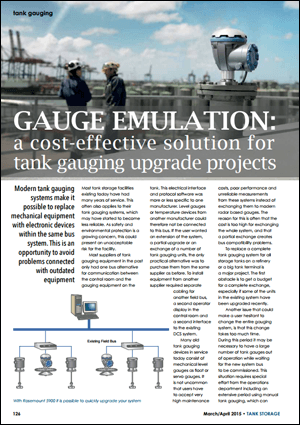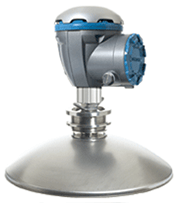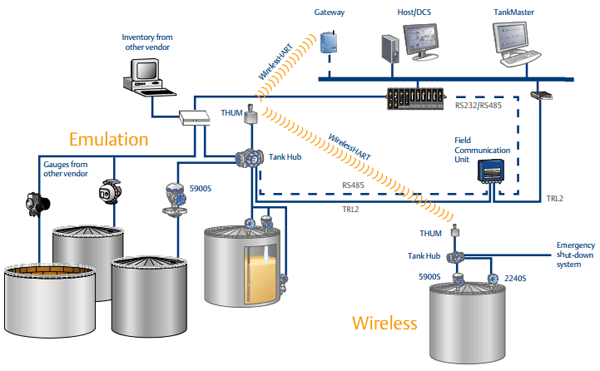Here in the US, we read many stories of oil tanks being filled to the brim with increased production from shale sources and federal law barring export. Whether in the US or anywhere across the globe, managing and reporting on the levels in these tanks require accurate measurement. Also, given the importance of these measurements in safety and environmental protection, accuracy and reliability is required, especially for older facilities with manual or aging tank gauging systems.

Hans Westerlind
Marketing Manager
 In a Tank Storage magazine article, Gauge Emulation: a cost-effective solution for tank gauging upgrade projects, Emerson’s Hans Westerlind shares how technology advancements make it possible to incrementally replace outdated mechanical level measurement devices with accurate electronic devices.
In a Tank Storage magazine article, Gauge Emulation: a cost-effective solution for tank gauging upgrade projects, Emerson’s Hans Westerlind shares how technology advancements make it possible to incrementally replace outdated mechanical level measurement devices with accurate electronic devices.
Older tank gauging systems often had proprietary communications between the measurement devices and the control system:
This electrical interface and protocol software was more or less specific to one manufacturer. Level gauges or temperature devices from another manufacturer could therefore not be connected to this bus. If the user wanted an extension of the system, a partial upgrade or an exchange of a number of tank gauging units, the only practical alternative was to purchase them from the same supplier as before.
Also these older measurement technologies:
…consist of mechanical level gauges as float or servo gauges. It is not uncommon that users have to accept very high maintenance costs, poor performance and unreliable measurements…
At a refinery or large tank farm, it can be a difficult undertaking to modernize the tank gauging systems:
The first obstacle is to get a budget for a complete exchange, especially if some of the units in the existing system have been upgraded recently.
Another issue that could make a user hesitant to change the entire gauging system, is that this change takes too much time.
Hans highlighted an additional challenge of the specialized interfaces that had to have been developed to move data between the tank gauging systems and the distributed control systems (DCS), accounting systems, inventory/loss control systems, etc. Given these reasons:
…a user may prefer his old level gauge system and therefore accepts having unreasonably high maintenance costs.
He describes a gauge emulation migration path to address these concerns. Emulation is when:
…an existing tank gauge installed on a tank can be exchanged by another totally different type of gauge. After this exchange, the existing tank gauging system will not see any difference between the new emulating level gauge and the old level gauges.
Requirements for this emulation include electrical compatibility between the gauge and the existing bus. The emulating gauge also needs to be software compatible with the existing system. This level of compatibility begins at measurement data only. Also configuration of the emulating device would not be done from the existing tank gauging system but from a handheld transmitter or PC supporting today’s open standards such as HART, WirelessHART, Foundation fieldbus and Modbus.
The final requirement is that the emulating gauge must be able to supply what the existing tank gauge system expects to receive. For example:
…pressure, density, flow rate or some other data is measured by the existing system, then the emulating level gauge must be able to produce the same measurement data.

Rosemount 5900S with parabolic antenna
…the modular design allows for emulation of a large number of other types of level gauges. In particular all major old types of mechanical level gauges can be emulated.
This emulation approach allows the gauges and ultimately the legacy tank gauge master system to be replaced incrementally over time. At this point:
…the company can also switch to the standard radar level gauge field bus, without any additional cost. The reason for this is that the gauges used for emulation in the old system are equipped with the standard radar level gauge field bus as well. It can be activated at any time. With the standard bus, all facilities for configuration service etc are available for the user.
Hans shows an example of a configuration with legacy gauges and software incorporating emulation and WirelessHART and Modbus protocols to bring the information back to the TankMaster software, control system, and inventory software platform:

Tank Gauging Architecture with Emulation
Hans concludes:
Project implementation can be far easier with a minimum of operational disturbances by doing a gradual exchange of an existing tank gauging system based on emulation. When full exchange has been achieved, the user has the option to select the type of field bus that he prefers at a minimum cost.
Read the article for a refinery example of how this modernization project can unfold. You can also connect and interact with other tank management experts in the Tank Gauging group in the Emerson Exchange 365 community.
